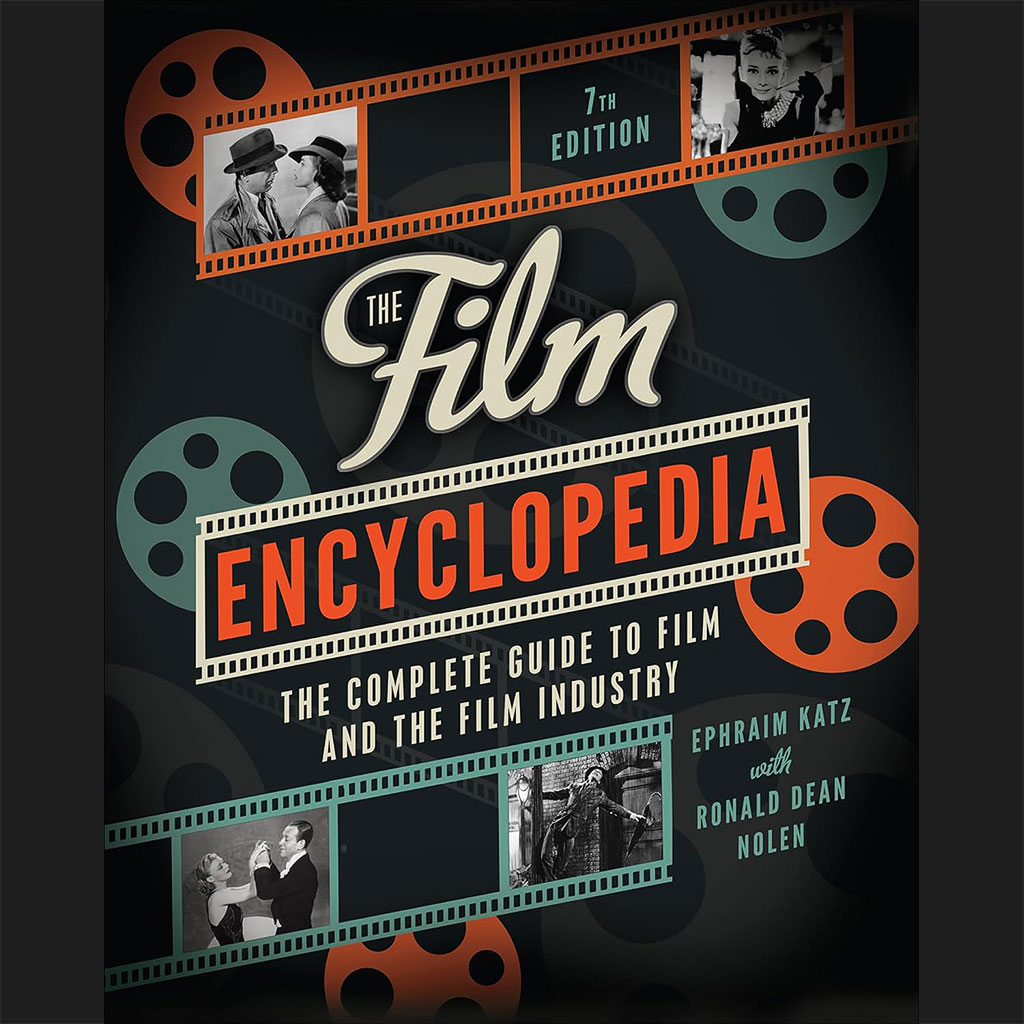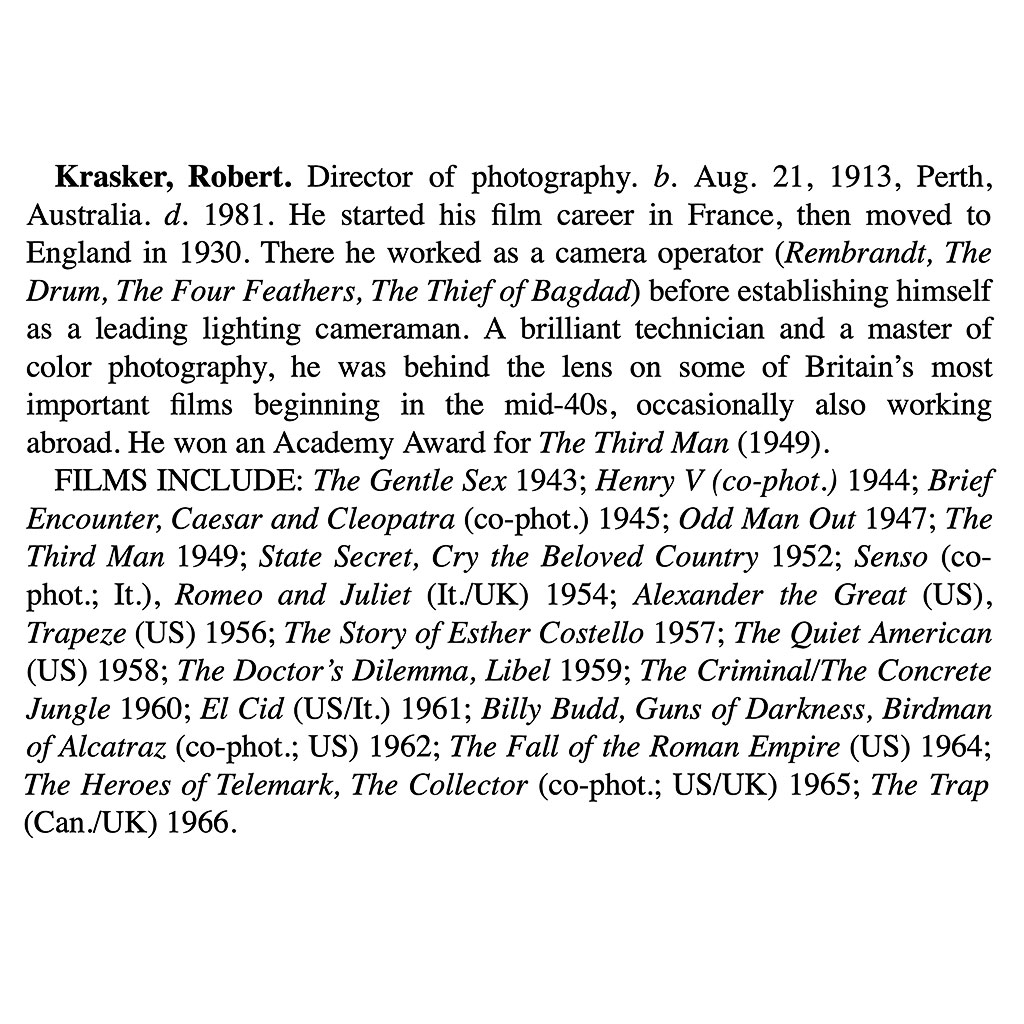
In order to compile a worthy collection of citations about the great Australian cinematographer Robert Krasker and the more than sixty feature films upon which he worked I’ve been searching through all the film dictionaries and encyclopedias that I can find.
Ephraim Katz’s and Ronald Dean Nolen’s The Film Encyclopedia 7th Edition: The Complete Guide To Film And The Film Industry appears to be highly regarded at least by Katherine Hepburn, “Wow! What a book!”, and Newsweek, “The best movie reference book, hands down”, so best for me to include it in my fact checks here at The Robert Krasker Project.
“Ephraim Katz’s The Film Encyclopedia is the most comprehensive single-volume encyclopedia on film and is considered the undisputed bible of the film industry.”
The Film Encyclopedia 7th Edition: The Complete Guide To Film And The Film Industry Paperback – 30 May 2012
by Ephraim Katz (Author), Ronald Dean Nolen (Author), https://www.amazon.com.au/Film-Encyclopedia-Complete-Guide-Industry/dp/0062026151/
I have been wondering where some of the common misconceptions about Robert Krasker and his films, or what some refer to as “alternative facts”, come from and this entry on him may offer some clues.
It is not only important but crucial to challenge “alternative facts”, that is facts that are not actually factual, given this is the era of “post-truth” but also because artificial intelligence is being trained on huge datasets of written material in digital form — referred to as Book1, Book2 and Book3.
Every so often I put AI-based search engines as well as chat and generative AI projects of various sorts to the test and despite their makers’ claims that they are improving, they continue to create what are referred to as “hallucinations” of fact.
More precisely, stuff that is made up and is based on nothing, or assumptions or conjecture.

Krasker, Robert. Director of photography. b. Aug. 21, 1913, Perth, Australia. d. 1981. He started his film career in France, then moved to England in 1930. There he worked as a camera operator (Rembrandt, The Drum, The Four Feathers, The Thief of Bagdad) before establishing himself as a leading lighting cameraman. A brilliant technician and a master of color photography, he was behind the lens on some of Britain’s most important films beginning in the mid-40s, occasionally also working abroad. He won an Academy Award for The Third Man (1949).
FILMS INCLUDE: The Gentle Sex 1943; Henry V (co-phot.) 1944; Brief Encounter, Caesar and Cleopatra (co-phot.) 1945; Odd Man Out 1947; The Third Man 1949; State Secret, Cry the Beloved Country 1952; Senso (co- phot.; It.), Romeo and Juliet (It./UK) 1954; Alexander the Great (US), Trapeze (US) 1956; The Story of Esther Costello 1957; The Quiet American (US) 1958; The Doctor’s Dilemma, Libel 1959; The Criminal/The Concrete Jungle 1960; El Cid (US/It.) 1961; Billy Budd, Guns of Darkness, Birdman of Alcatraz (co-phot.; US) 1962; The Fall of the Roman Empire (US) 1964; The Heroes of Telemark, The Collector (co-phot.; US/UK) 1965; The Trap (Can./UK) 1966.
One such “fact” that has found some traction online and in reference books is that Robert Krasker was one of the cinematographers on Birdman of Alcatraz.
A more common one is that he was born in Perth, and there are more with many of them quite odd such as “he trained and worked in a succession of photography studios in Australia before moving to Europe”.
All that aside, this quote from The Film Encyclopedia may prove useful for the revision and enlargement of the Robert Krasker entry in Wikipedia:
“A brilliant technician and a master of color photography, he was behind the lens on some of Britain’s most important films beginning in the mid-40s, occasionally also working abroad.”
Fact Checks
- “b. Aug. 21, 1913, Perth, Australia.” – Robert Krasker was born on 21 August 1913 in Alexandria in Egypt during a stopover by his parents while on a business trip from Western Australia to Europe and back.
- “He started his film career in France, then moved to England in 1930.” – Robert Krasker began working in the film industry at Les Studios Paramount in Joinville-le-Pont. So far I don’t have the exact date that he started work there nor precisely when he moved to England to be with the rest of his family, but it looks like he began working for Paramount in France late 1930 or early 1931 then moved to England later in 1931.
- “Henry V (co-phot.) 1944″ – Robert Krasker was Director of Photography on Henry V, and was not its co-photographer. Instead he employed a camera team that included a camera operator, clapper/loader, focus-puller and so on. The distinction between Director of Photography aka lighting cameraman aka cinematographer and camera operator needs to be recognized.
- “Birdman of Alcatraz (co-phot.; US) 1962″ – Robert Krasker was not co-photographer of Birdman of Alcatraz nor did he work on it in any other capacity.
